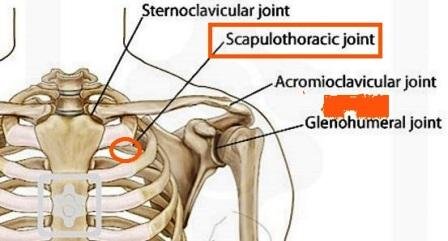Scapulothoracic Joint
Anatomy of scapulothoracic joint
Scapulothoracic joint is not an actual joint similar to the other synovial joints. Scapulothoracic joint that can be termed as scapulothoracic articulation is the point of attachment of various muscles and joints which allow movement of hand, neck, shoulder and other associated parts. The convex surface of the posterior thoracic rib cage and the concave surface of the anterior scapula makes scapulothoracic articulation. The involvement of the thoracic rib cage is located at level 2 – 7 ribs.

Image 1 – image showing scapulothoracic joint (highlighted)
The scapula is a shoulder flat bone; gliding is feasible due to presence of bursa which is angularly positioned at superior, inferior and base of the scapular spine. Scapula is joined with axial skeleton by acromioclavicular joint and sternoclavicular joint. Scapula forms articulation with arm bone (humerus) and collar bone (clevical).
The attached muscles which are anatomically surrounded with scalpula are shoulder muscles, back muscles, chest muscles and neck muscles. The scapulothoracic articulation assists to shoulder lifting. The ratio which is maintained between glenohumeral and scapulothoracic lifting is 20: 10.
Functions of Scapulothoracic Joint
- Scapulothoracic joint assists in the movement of shoulder blade (Scapula) along with thoracic rib cage. The movement are of three types which includes primary movement means up and down of the hand, secondary movement means rotation of hand and towards and forwards direction from spine and shoulder abduction means motion between glenohumeral and scapulothoracic.
- Scapulothoracic joint maintain the balance between extension and tension of glenohumeral muscles. Scapula allows a wide range of rotation. The muscle length is adjacent with scapula’s ascendant rotation. This assists to hold the muscular tension during the movement. Without the scapulothoracic joint, glenohumeral muscles are unable to maintain the stability which leads to reduction of the muscular strength and imbalance muscular tension. This affects other adjoining muscles functioning.
- It protects impingement between upper arm bone and acromion. The unmatched size of glenoid fossa and humeral head causes restricted movement, if subacromial impingement is not present between them.
Clinical Significance of Scapulothoracic Joint
Clinical significance of scapulothoracic joint is to provide attachment of various muscles and can control, stabilize muscular movement.
Three clinical conditions that are associated with scapulothoracic joint are:
- Scapulothoracic dissociation
- Scapular winging
- Scapulothoracic dyskinesis
Scapulothoracic Dissociation
A traumatic interruption of the scapulothoracic articulation frequently connected with nervous system injuries, vascular damage, and musculoskeletal injuries. It significantly affect lungs, heart and chest wall. Mortality is rare but quality of life may hamper in severe case where amputation is only option, especially in case of neurological injury.
Scapular Winging
This is of two types – medial winging and lateral winging.
Medial Winging: It occurs due to injury in long thoracic nerve at C5, C6 or C7 which causes insufficiency in serratus anterior. In this condition patient complains for shoulder blade pain, do not get sufficient strength during weight lifting or overhead activities, and feels pain during sitting on chair. This can occur in the following conditions:
- Past surgical history
- Continuous stretching in scapulothoracic joint, mostly in case of heavy weight lifting or volleyball playing
- Nervous system compression, common for athletes.
Lateral Winging: It occurs due to injury in spinal nerve at CNXI which causes insufficiency in Trapezius. This occurs due to surgical procedures in the subsequent part of the neck due to neurological degenerative diseases or general surgery in lymph nodes.
Scapulothoracic Dyskinesis
It can be denoted as atypical scapula movement which impacts on shoulder functionality. This type of disorder is common for athletes. Different factors which cause scapulothoracic dyskinesis are:
- Nervous system disorder
- Excessive external curving of the spine, causing swelling of the scapula
- Associated muscle weariness
- Pain in the shoulder blade and neck
